David Bowie’s cultural mash-ups echoed screenwriter Dennis Potter – and their deaths were strangely aligned too
Our need for David Bowie is the need for originality over novelty

It is three years since David Bowie died. In that observation, it is not the “three years” that seems odd (though it does, three fleeting years). David Bowie simply doesn’t seem “dead”. And that’s not some banality about his work “living on”, but because the need for him exists and persists.
What is the need for David Bowie? It is the need for originality over novelty. Everyone, on some level, thinks music is somehow not as good now as it was then (it never is, and it always is) – but the point is that we don’t know we need a Bowie (or a Prince or a Leonard Cohen) until such a person happens along.
When Bowie did eventually happen along – there were several “false starts” – it was not so much his Ziggy Stardust persona but his originality, the decision to adopt a persona at all, that marked the first step in the expansion of post-Beatles UK pop music.
In the dark chaos of Brexit there is a danger in drawing attention to a phenomenon that is of “UK origin”, maybe a “UK confection” is a better word for it – Bowie was a chef and his larder was popular culture.
The ingredients came from every shelf and he threw them into the mix with an apparently carefree abandon that belied the concentration driving his output. Consider the 16-year-old David Jones posing on his band’s, the Konrads’, kick-drum.

Here is a band that never made a record, but you wouldn’t know that from the poise and elegance of its sax player.
The balance, the insouciance, the attention to detail; not a hair out of place and a gaze that looks through the camera lens – blond ambition.
But a 16-year-old does not have all the references he needs to convert ambition into impact. If this is phase one, then phase two is dialling up the chutzpah to soak in and synthesise what cuts through the commonplace.
The stuttering bands and record deals, even the hit with “Space Oddity”, were never “it”; “it” was Hunky Dory.
On Hunky Dory, the band is in place, the hair is blonde and now it is long – but it is not “hippie”, it is a New York look, not an Altamont one, and the key cultural reference is Andy Warhol.
With Andy Warhol as his “monument” (check out the sleeve notes), David Jones realised “David Bowie”, and that David Bowie was the point of synthesis of every aspect of popular culture that he believed cut through the noise; that differentiated itself through originality before its assimilation into the “normal” and the “everyday”.
What Warhol painted was not fruit in a bowl, but a commodity made of fruit processed for convenience and profit. Bowie swallowed the idea and regurgitated it in his version of a Blade Runner future, one in which humans and cyborgs co-existed, neither was sure of the difference, and both were the envy of each other.
From this point, curation, assimilation, synthesis became his modus and he continued until his death – orchestrating Black Star as his final curtain with his consistent, persistent and trademark verve. Striking similarities exist between this terminal project and that of Dennis Potter, and it does not seem a coincidence.
Potter was to television what Bowie was to popular music – an original writer who assimilated popular culture and reconfigured and repositioned recognisable elements in new and often jarring contexts, producing new perspectives and sensations as he went.
Potter used the work of crooners (Al Bowly – Moonlight on the Highway) and familiar Tin Pan Alley songs (The Singing Detective) as soundtrack material for explorations of demanding experiences (for example, his own experience of sexual abuse and of chronic illness).
David Bowie’s last single was Lazarus, Potter’s last television film was Cold Lazarus. In his morphine-swigging interview with Melvyn Bragg, Potter gave us access to his dying; Bowie did not emulate him but gave us the shock of the announcement instead.
That shock persists; the need he filled in his own way persists, too.
Mike Jones is course director MA (Music Industries), at the University of Liverpool


Join our commenting forum
Join thought-provoking conversations, follow other Independent readers and see their replies